Radu Tudor Ionescu
Curriculum Multi-Task Self-Supervision Improves Lightweight Architectures for Onboard Satellite Hyperspectral Image Segmentation
Sep 16, 2025Abstract:Hyperspectral imaging (HSI) captures detailed spectral signatures across hundreds of contiguous bands per pixel, being indispensable for remote sensing applications such as land-cover classification, change detection, and environmental monitoring. Due to the high dimensionality of HSI data and the slow rate of data transfer in satellite-based systems, compact and efficient models are required to support onboard processing and minimize the transmission of redundant or low-value data, e.g. cloud-covered areas. To this end, we introduce a novel curriculum multi-task self-supervised learning (CMTSSL) framework designed for lightweight architectures for HSI analysis. CMTSSL integrates masked image modeling with decoupled spatial and spectral jigsaw puzzle solving, guided by a curriculum learning strategy that progressively increases data complexity during self-supervision. This enables the encoder to jointly capture fine-grained spectral continuity, spatial structure, and global semantic features. Unlike prior dual-task SSL methods, CMTSSL simultaneously addresses spatial and spectral reasoning within a unified and computationally efficient design, being particularly suitable for training lightweight models for onboard satellite deployment. We validate our approach on four public benchmark datasets, demonstrating consistent gains in downstream segmentation tasks, using architectures that are over 16,000x lighter than some state-of-the-art models. These results highlight the potential of CMTSSL in generalizable representation learning with lightweight architectures for real-world HSI applications. Our code is publicly available at https://github.com/hugocarlesso/CMTSSL.
MAVOS-DD: Multilingual Audio-Video Open-Set Deepfake Detection Benchmark
May 16, 2025Abstract:We present the first large-scale open-set benchmark for multilingual audio-video deepfake detection. Our dataset comprises over 250 hours of real and fake videos across eight languages, with 60% of data being generated. For each language, the fake videos are generated with seven distinct deepfake generation models, selected based on the quality of the generated content. We organize the training, validation and test splits such that only a subset of the chosen generative models and languages are available during training, thus creating several challenging open-set evaluation setups. We perform experiments with various pre-trained and fine-tuned deepfake detectors proposed in recent literature. Our results show that state-of-the-art detectors are not currently able to maintain their performance levels when tested in our open-set scenarios. We publicly release our data and code at: https://huggingface.co/datasets/unibuc-cs/MAVOS-DD.
Rip Current Segmentation: A Novel Benchmark and YOLOv8 Baseline Results
Apr 03, 2025Abstract:Rip currents are the leading cause of fatal accidents and injuries on many beaches worldwide, emphasizing the importance of automatically detecting these hazardous surface water currents. In this paper, we address a novel task: rip current instance segmentation. We introduce a comprehensive dataset containing $2,466$ images with newly created polygonal annotations for instance segmentation, used for training and validation. Additionally, we present a novel dataset comprising $17$ drone videos (comprising about $24K$ frames) captured at $30 FPS$, annotated with both polygons for instance segmentation and bounding boxes for object detection, employed for testing purposes. We train various versions of YOLOv8 for instance segmentation on static images and assess their performance on the test dataset (videos). The best results were achieved by the YOLOv8-nano model (runnable on a portable device), with an mAP50 of $88.94%$ on the validation dataset and $81.21%$ macro average on the test dataset. The results provide a baseline for future research in rip current segmentation. Our work contributes to the existing literature by introducing a detailed, annotated dataset, and training a deep learning model for instance segmentation of rip currents. The code, training details and the annotated dataset are made publicly available at https://github.com/Irikos/rip_currents.
* Accepted at CVPR 2023 NTIRE Workshop
RipVIS: Rip Currents Video Instance Segmentation Benchmark for Beach Monitoring and Safety
Apr 03, 2025Abstract:Rip currents are strong, localized and narrow currents of water that flow outwards into the sea, causing numerous beach-related injuries and fatalities worldwide. Accurate identification of rip currents remains challenging due to their amorphous nature and the lack of annotated data, which often requires expert knowledge. To address these issues, we present RipVIS, a large-scale video instance segmentation benchmark explicitly designed for rip current segmentation. RipVIS is an order of magnitude larger than previous datasets, featuring $184$ videos ($212,328$ frames), of which $150$ videos ($163,528$ frames) are with rip currents, collected from various sources, including drones, mobile phones, and fixed beach cameras. Our dataset encompasses diverse visual contexts, such as wave-breaking patterns, sediment flows, and water color variations, across multiple global locations, including USA, Mexico, Costa Rica, Portugal, Italy, Greece, Romania, Sri Lanka, Australia and New Zealand. Most videos are annotated at $5$ FPS to ensure accuracy in dynamic scenarios, supplemented by an additional $34$ videos ($48,800$ frames) without rip currents. We conduct comprehensive experiments with Mask R-CNN, Cascade Mask R-CNN, SparseInst and YOLO11, fine-tuning these models for the task of rip current segmentation. Results are reported in terms of multiple metrics, with a particular focus on the $F_2$ score to prioritize recall and reduce false negatives. To enhance segmentation performance, we introduce a novel post-processing step based on Temporal Confidence Aggregation (TCA). RipVIS aims to set a new standard for rip current segmentation, contributing towards safer beach environments. We offer a benchmark website to share data, models, and results with the research community, encouraging ongoing collaboration and future contributions, at https://ripvis.ai.
ExDDV: A New Dataset for Explainable Deepfake Detection in Video
Mar 18, 2025Abstract:The ever growing realism and quality of generated videos makes it increasingly harder for humans to spot deepfake content, who need to rely more and more on automatic deepfake detectors. However, deepfake detectors are also prone to errors, and their decisions are not explainable, leaving humans vulnerable to deepfake-based fraud and misinformation. To this end, we introduce ExDDV, the first dataset and benchmark for Explainable Deepfake Detection in Video. ExDDV comprises around 5.4K real and deepfake videos that are manually annotated with text descriptions (to explain the artifacts) and clicks (to point out the artifacts). We evaluate a number of vision-language models on ExDDV, performing experiments with various fine-tuning and in-context learning strategies. Our results show that text and click supervision are both required to develop robust explainable models for deepfake videos, which are able to localize and describe the observed artifacts. Our novel dataset and code to reproduce the results are available at https://github.com/vladhondru25/ExDDV.
Task-Informed Anti-Curriculum by Masking Improves Downstream Performance on Text
Feb 18, 2025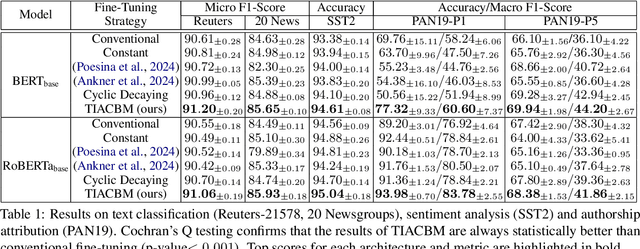


Abstract:Masked language modeling has become a widely adopted unsupervised technique to pre-train language models. However, the process of selecting tokens for masking is random, and the percentage of masked tokens is typically fixed for the entire training process. In this paper, we propose to adjust the masking ratio and to decide which tokens to mask based on a novel task-informed anti-curriculum learning scheme. First, we harness task-specific knowledge about useful and harmful tokens in order to determine which tokens to mask. Second, we propose a cyclic decaying masking ratio, which corresponds to an anti-curriculum schedule (from hard to easy). We exemplify our novel task-informed anti-curriculum by masking (TIACBM) approach across three diverse downstream tasks: sentiment analysis, text classification by topic, and authorship attribution. Our findings suggest that TIACBM enhances the ability of the model to focus on key task-relevant features, contributing to statistically significant performance gains across tasks. We release our code at https://github.com/JarcaAndrei/TIACBM.
A Survey of Text Classification Under Class Distribution Shift
Feb 18, 2025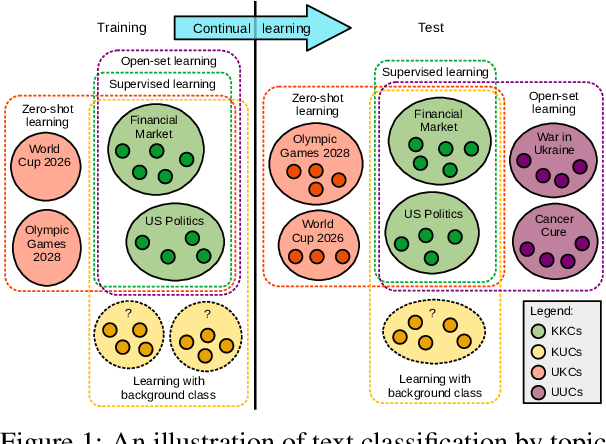
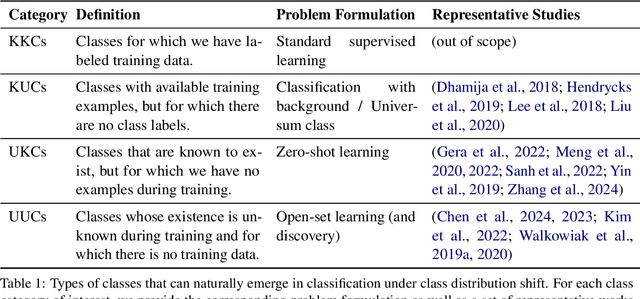
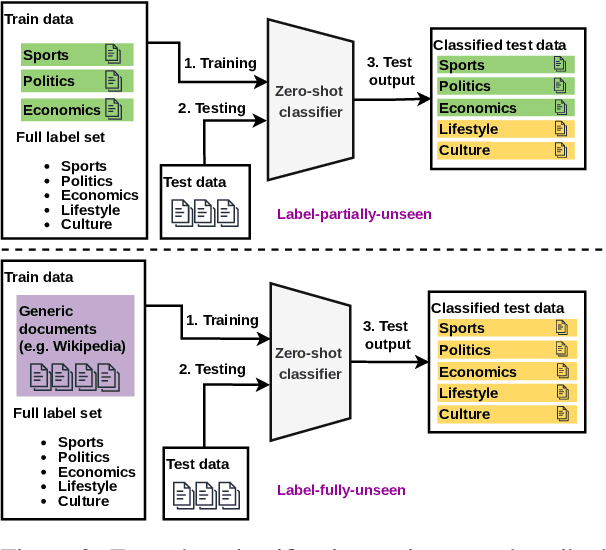
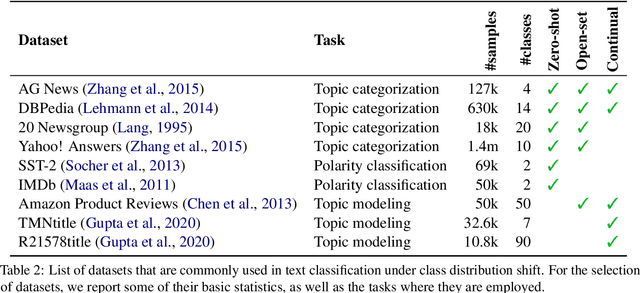
Abstract:The basic underlying assumption of machine learning (ML) models is that the training and test data are sampled from the same distribution. However, in daily practice, this assumption is often broken, i.e.~the distribution of the test data changes over time, which hinders the application of conventional ML models. One domain where the distribution shift naturally occurs is text classification, since people always find new topics to discuss. To this end, we survey research articles studying open-set text classification and related tasks. We divide the methods in this area based on the constraints that define the kind of distribution shift and the corresponding problem formulation, i.e.~learning with the Universum, zero-shot learning, and open-set learning. We next discuss the predominant mitigation approaches for each problem setup. Finally, we identify several future work directions, aiming to push the boundaries beyond the state of the art. Interestingly, we find that continual learning can solve many of the issues caused by the shifting class distribution. We maintain a list of relevant papers at https://github.com/Eduard6421/Open-Set-Survey.
Large Multimodal Models for Low-Resource Languages: A Survey
Feb 08, 2025



Abstract:In this survey, we systematically analyze techniques used to adapt large multimodal models (LMMs) for low-resource (LR) languages, examining approaches ranging from visual enhancement and data creation to cross-modal transfer and fusion strategies. Through a comprehensive analysis of 106 studies across 75 LR languages, we identify key patterns in how researchers tackle the challenges of limited data and computational resources. We find that visual information often serves as a crucial bridge for improving model performance in LR settings, though significant challenges remain in areas such as hallucination mitigation and computational efficiency. We aim to provide researchers with a clear understanding of current approaches and remaining challenges in making LMMs more accessible to speakers of LR (understudied) languages. We complement our survey with an open-source repository available at: https://github.com/marianlupascu/LMM4LRL-Survey.
Deepfake Media Generation and Detection in the Generative AI Era: A Survey and Outlook
Nov 29, 2024



Abstract:With the recent advancements in generative modeling, the realism of deepfake content has been increasing at a steady pace, even reaching the point where people often fail to detect manipulated media content online, thus being deceived into various kinds of scams. In this paper, we survey deepfake generation and detection techniques, including the most recent developments in the field, such as diffusion models and Neural Radiance Fields. Our literature review covers all deepfake media types, comprising image, video, audio and multimodal (audio-visual) content. We identify various kinds of deepfakes, according to the procedure used to alter or generate the fake content. We further construct a taxonomy of deepfake generation and detection methods, illustrating the important groups of methods and the domains where these methods are applied. Next, we gather datasets used for deepfake detection and provide updated rankings of the best performing deepfake detectors on the most popular datasets. In addition, we develop a novel multimodal benchmark to evaluate deepfake detectors on out-of-distribution content. The results indicate that state-of-the-art detectors fail to generalize to deepfake content generated by unseen deepfake generators. Finally, we propose future directions to obtain robust and powerful deepfake detectors. Our project page and new benchmark are available at https://github.com/CroitoruAlin/biodeep.
DLCR: A Generative Data Expansion Framework via Diffusion for Clothes-Changing Person Re-ID
Nov 11, 2024



Abstract:With the recent exhibited strength of generative diffusion models, an open research question is \textit{if images generated by these models can be used to learn better visual representations}. While this generative data expansion may suffice for easier visual tasks, we explore its efficacy on a more difficult discriminative task: clothes-changing person re-identification (CC-ReID). CC-ReID aims to match people appearing in non-overlapping cameras, even when they change their clothes across cameras. Not only are current CC-ReID models constrained by the limited diversity of clothing in current CC-ReID datasets, but generating additional data that retains important personal features for accurate identification is a current challenge. To address this issue we propose DLCR, a novel data expansion framework that leverages pre-trained diffusion and large language models (LLMs) to accurately generate diverse images of individuals in varied attire. We generate additional data for five benchmark CC-ReID datasets (PRCC, CCVID, LaST, VC-Clothes, and LTCC) and \textbf{increase their clothing diversity by \boldmath{$10$}x, totaling over \boldmath{$2.1$}M images generated}. DLCR employs diffusion-based text-guided inpainting, conditioned on clothing prompts constructed using LLMs, to generate synthetic data that only modifies a subject's clothes while preserving their personally identifiable features. With this massive increase in data, we introduce two novel strategies - progressive learning and test-time prediction refinement - that respectively reduce training time and further boosts CC-ReID performance. On the PRCC dataset, we obtain a large top-1 accuracy improvement of $11.3\%$ by training CAL, a previous state of the art (SOTA) method, with DLCR-generated data. We publicly release our code and generated data for each dataset here: \url{https://github.com/CroitoruAlin/dlcr}.
 Add to Chrome
Add to Chrome Add to Firefox
Add to Firefox Add to Edge
Add to Edge